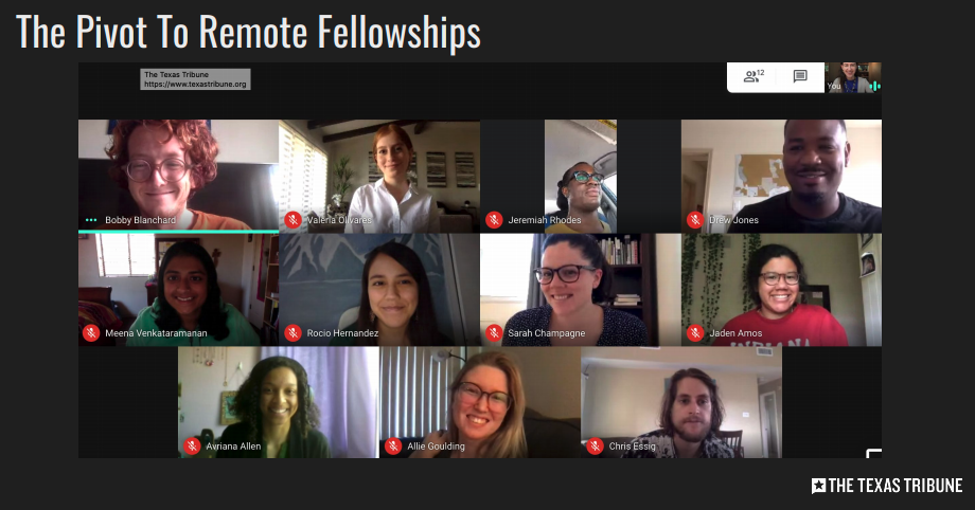How to host an intern: Advice from nonprofit news leaders
INN members lead the way in creating valuable internship programs for the next generation of journalism leaders

By: Vignesh Ramachandran and Emily Roseman for the Institute for Nonprofit News
Introduction
Journalism internships are notorious for enabling the whiter and wealthier to climb a career ladder, leaving people of color and others from less-privileged backgrounds disadvantaged. Some journalism students are encouraged to take on unpaid work, leaving students who can’t afford to work for free with less “experience” to list on a resume.
These days, many leaders at nonprofit news organizations have demonstrated a commitment to providing better internship experiences for rising journalism professionals around the country. The Institute for Nonprofit News reached out to a handful of our members to learn what they’re doing to turn internship programs into positive and equitable accelerators.
Below, we list eight key pieces of advice to consider when hosting an intern.
1. Pay interns a fair wage.
Above all, pay your interns for their work. Know your state’s minimum wage, and treat this benchmark as the floor, not the ceiling. If you can’t afford to pay your interns for full-time, 40 hours/week of work, consider structuring internships as paid, part-time commitments (part-time each day, or two to three days per week) that enable your interns to find additional income.
- NOWCastSA.com, based in San Antonio, Texas, pays interns through a few different partnerships. Some funding for interns comes from work study programs at local colleges, including UTSA or the Alamo Colleges. Other interns come through a Students + Startups summer internship program where NOWCastSA pays half and the 80/20 Foundation pays half. In other instances, NOWCastSA pays the interns out of their own budget, at a minimum of $15 per hour for their work.
- New Mexico In Depth pays interns $750 per month for about 10 hours of work per week. Interns are typically students at nearby universities or colleges, and internships at New Mexico In Depth are set up to fit within a student’s semester schedule. New Mexico In Depth began funding the fellowships itself and later interested funders to help pay for the program.
- The Texas Tribune pays its fellows $6,000 per semester and tries to ensure that hours are consistent. “If you can’t afford to pay them a wage, have fewer interns,” former Managing Editor Corrie MacLaggan recommends. “More is not better with the interns. We need to give each intern the support they need.”
- Wisconsin Watch pays undergrad interns $12.50 to $15 an hour, depending upon experience and skill levels, and the length of tenure with the news outlet. Recent grads and grad students may earn up to $20 an hour. The outlet sometimes secures full or partial funding for interns from universities with strong journalism schools (Columbia University, the University of Missouri, CUNY), the Fulbright Scholar program, and private and public schools in Wisconsin and Minnesota.
- Type Investigations, based in New York, pays $18/hr plus a monthly tech or transit stipend (tech if the intern is remote).
TIP: Don’t have the funds to pay your interns? Consider approaching local foundations or funders to ask for support. Philanthropic groups can also take action themselves — the Lenfest Institute offers funds to help subsidize unpaid internship programs for Philadelphia-area journalists and students of color with their professional development. Affinity groups, like the Asian American Journalists Association, also offer grants for students to help supplement internship pay.
2. Commit to hiring interns that represent the community your news organization serves. Actively recruit interns who come from less privilege.
This means going beyond posting your internship opportunities on job boards and tapping the usual networks. Instead, it means actively looking for journalists and journalists-to-be outside the world of prestigious, four-year universities.
- NOWCastSA hires interns who reflect the city the outlet serves. Almost two-thirds of San Antonio identifies as Hispanic, according to the U.S. Census data, and 76% of the news organization’s interns have been people of color. Charlotte-Anne Lucas, executive director of NOWCastSA, says she works hard to develop relationships with local colleges and universities who help recruit talented students looking for experience in a news organization. When Lucas meets an exceptional student, she’ll get creative in bringing them into the organization — looking for an ideal role that can match the student, instead of the other way around. For example, one NOWCastSA applicant had computer science skills, so Lucas brought them on board to help with their website.
- Voice of OC utilizes partnerships with local colleges to help with recruitment. Sonya Quick, the outlet’s digital editor, leverages her connections as someone who teaches journalism at Chapman College in order to recruit interns from non-elite spaces across Orange County, California.
- Madison365 in Wisconsin explained in an INN case study how recruiting a diverse team of journalists and staff requires the team to be proactive throughout their recruitment and hiring processes — especially since Madison is a predominantly white city (according to U.S. Census data, it is 78% white). For starters, Executive Editor Rob Chappell looks outside of the J-school space to nearby community colleges for leads on employees or freelancers, and considers candidates with non-journalism-specific backgrounds (like in business or education).
3. Craft clear and inclusive job descriptions.
Job descriptions are important. If your job description is too specific in the qualifications and skills you require, it could dissuade potentially qualified applicants who just aren’t familiar with journalism terminology. Instead, consider what are the truly essential skills and needs of your organization. Above all, focus on communicating your organization’s values in your job description.
- The Texas Tribune’s application process doesn’t emphasize experience covering politics and policy but rather encourages fellows to articulate specifically why they want to work at the Tribune. That could help find interns who are better fit to your specific organization over just any newsroom. See how the Texas Tribune promotes the different internship opportunities in their news organization here.
- CalMatters, a statewide outlet dedicated to covering California’s state Capitol, is very clear in its job descriptions about what the intern can expect to focus on during their time with the outlet. Some internship positions even include links to sample projects.
Tip: OpenNews’ DEI Coalition for Anti-Racist, Equitable and Just Newsrooms has member-only resources that provide tips on inclusive job descriptions, recruiting and interviewing.
4. Know this: Interns should get more value out of the internship than you do.
This is a big one, and might require a mindset shift. Interns are not cheap labor. Interns may be more costly for your news organization up front, given the amount of time, mentorship and coaching they will need to grow while under your care.
- Voice of OC’s Sonya Quick recommends keeping this in mind: “A lot of publishers think they can bring on more interns to get more content. But depending on how green they are it can take a lot of [training] to work with someone until they’re firing away.” If you can’t provide the time and resources to host an intern properly, then you’re not ready to host an intern. As Quick puts it: “In a time-demanding profession, making a commitment to deliver a learning experience for student journalists, every year, can be time-consuming. Don’t bring on an intern just to check a box. If none of the intern applicants bring value to your team or your team is strapped for time, be empowered to say no and hold off on accepting interns for that semester.”
- Detour Media’s CEO Ashley Woods Branch explains that at the beginning of an internship experience she creates a shared document between the intern and news organization that puts down both the intern’s and the news organization’s expectations “on paper.” Then, she encourages going back to this document regularly in meetings to see how you are progressing toward the intern’s goals. This practice helps Woods Branch identify new opportunities for interns to grow. For example, one intern was interested in potentially running a social media account for a news organization someday, so Woods Branch assigned her the job of reviewing the current social media scheduling platforms in the organization’s budget and presenting the best choice for the company.
Tip: Consider what support people of color will need when operating in your news organization’s culture, especially if your news outlet’s leadership is mostly white and/or your news outlet operates in a predominantly white area. Management consultant Kim-Monique Johnson advocates for managers to start by rethinking even calling their own roles “supervisors” or any other label that’s rooted in racism and the replication of harmful work norms. Johnson advocates for using the pandemic as a transition toward a new normal in work cultures that are more humane and active in “lifting up the power and promise of marginalized groups.”
5. During onboarding, define clear working norms.
Your internship program might be the first time your intern is using email, Slack and other tools in professional settings. Make sure you communicate to your intern(s) how and when you expect them to use these tools and platforms throughout their time working at your news organization.
- CalMatters is clear about its intentions and goals for interns very early on. The organization has an internal internship guide that outlines the program’s goals, process to request an intern and the general structure of the internship experience. “We aim to foster a culture where interns feel supported and equipped to produce high-quality, engaging journalism,” the guide reads. Staffers must fill out a “request for intern” form which requires going through a thought process of outlying an intern’s functions, assignments and management — all done far ahead of an intern entering the newsroom.
- The Texas Tribune kicks off its fellowship program with an organized orientation that sets the stage for the experience. “Nobody should feel unwelcome, so welcome them,” MacLaggan says. Fellows get to meet editors, editorial staffers and other management throughout a daylong agenda, which includes a crash course in the Texas legislature and introductions to various departmental functions. During the COVID-19 pandemic, the orientation even incorporated a tip session about making the most of a remote fellowship. In non-pandemic times, the orientation generally included a tour of the Texas Capitol, including where press gather.
- Orb Media, an outlet that covers environmental and social sustainability, believes it’s important to be clear with interns on your organization’s: 1) Communications hierarchy, including the platforms you use for different levels of urgency, 2) Remote working expectations, including when and how they should be available or online, and 3) Email expectations: On email expectations, take the time to teach your interns the basics in email subject lines, email filters and how to craft tl;drs at the tops of long emails.
TIP: For your editorially focused interns, consider the things specific to your outlet that they should know. This includes the threshold for when your outlet tends to cover a topic or story vs not, and whether and when you expect your intern to help with breaking news. Also, help your interns understand how your outlet manages relationships with sources (and how interns should introduce themselves and explain their role before an interview). Finally, be sure to clearly define how interns can prepare for a fact-checking process, such as keeping fact-checks linked in their drafts, and keeping interview transcripts accessible for editors.
6. Don’t forget about your intern.
Throughout the program, it is your responsibility to manage, mentor and check-in with your intern. Schedule regular check-ins!
- Orb Media’s CEO Victoria Fine recommends assigning your intern a “buddy” who isn’t you, to have as a resource for questions (without the lens of being a boss or manager). If possible, ensure that buddy is a person of the same gender or ethnicity, as it may help your intern feel more comfortable speaking up.
- New Mexico In Depth’s Executive Director, Trip Jennings, says the organization has incorporated training opportunities into the internship program, which includes requesting public records and what to say in emails. The organization had a Santa Fe attorney talk about how to use open records. In 2020, some of New Mexico In Depth’s fellows took advantage of New Mexico In Depth’s partnership with ProPublica as part of its local news program to receive training, too. Jennings also advocates for regular calls with interns to talk through ideas and to help connect with sources.
- The Texas Tribune matches their fellows with mentors, who are not their boss but function as a guide to help the fellow navigate the organization and the city. The Tribune sometimes does interdisciplinary matches — pairing an engineering fellow with an events director, for example. That way interns can meet people across the organization and better understand how to work across teams. Mentors are then trained by the Tribune on how to support and help their mentees throughout the course of the program.
Use this resource: Corrie MacLaggan, The Texas Tribune’s former managing editor, compiled this Tip sheet on how to be a great mentor, including advice and tips from Whitnie Narcisse of First Round Capital, Amy Kovac-Ashley of the American Press Institute and the participants of the Online News Association Journalism Mentorship Collaborative.

7. Collect and incorporate feedback on your internship program.
After the internship ends, ask your intern(s) for their feedback on how your outlet can improve the internship experience. Ideally, allow for anonymity.
- Orb Media asks interns to develop a report on what they learned and recommendations they have for the organization that could be due at the end of their internship that they can then present. Fine says this project gives interns ownership over the process and an outlet to think systemically and managerially about the experience.
- New Mexico In Depth’s executive director (Jennings) says that previously, the newsroom’s internship program had interns work on several stories, but it involved a lot of capacity to edit. They’ve since moved to a model where interns work on one big project per semester.
- CalMatters seeks feedback from both the intern and their manager at the end of the program. Interns fill out a survey that candidly asks about highlights but also about challenges and what they would change about the experience. Managers fill out an intern evaluation form that asks for the intern’s major accomplishments and strengths. It also asks a key, forward-thinking question and can be constructive feedback: “In which areas would you need to see improvement before you would consider hiring this intern for a full-time position?” Mentors for the intern in the newsroom also fill out a form about their experience.
- The Texas Tribune has fellows fill out a survey both at the midpoint and end of the fellowship program. It asks questions about how the news outlet can improve the orientation process, what the mentorship experience was like, and the usefulness of the workshops.
8. Be proactive in helping your intern navigate the post-internship landscape.
If you can’t hire your intern full-time, get involved in their job-hunting process. Transition from mentor to advocate. Help write recommendation letters and serve as a reference. Use your own networks to make introductions at other news organizations and get their resume noticed.
- Voice of OC’s Quick believes you can support your interns even after their internship has ended: “Be prepared to share their stories with potential funders and with your audience,” she says. If budget is the barrier to bringing the intern onto your team in a permanent position, use the young journalists’ time in the newsroom to make an appeal to readers for why receiving more revenue would help expand your staff.
- The Texas Tribune helps showcase their fellows’ work through samples linked on a landing page. The organization also continues to track the careers of its former fellows. Past fellows, for example, have moved on to organizations ranging from the Sacramento Bee to the Washington Post to Politico.
Conclusion
A positive internship program involves investment in staff time, organization budget and a genuine desire to mentor the next generation of journalists, publishers and news outlet leaders.
As the journalism industry grapples with diversity, equity and inclusion, developing or improving your internship program can help foster a diverse pipeline of young, vibrant talent that will become our country’s top journalism leaders for decades to come.
